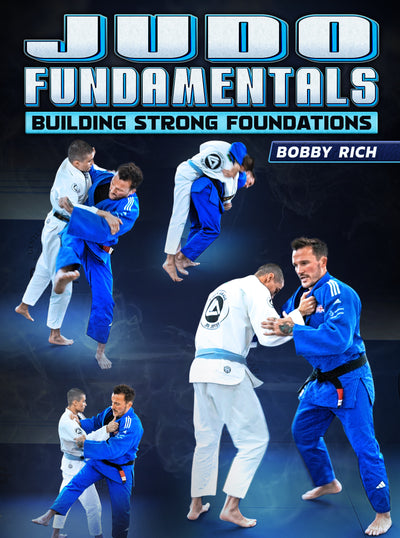Judo Vs. BJJ With Ugo Legrand
Judoka Ugo Legrand won a Bronze medal at the 2012 Olympics, 2nd and 3rd place in the World Championship (2013 and 2011 respectively), was a Gold and Bronze medal winner in the European Championship (2012 and 2010 respectively) and is also a Blue Belt in BJJ. So speaking with Ugo is a great opportunity to learn about how Judo and BJJ interact with each other from the standing game.
The first thing to note is the clear difference in standing stances that tend to be there between BJJ and Judo. As Bernardo notes BJJ guys tend to bend forward at the waist in a similar fashion to wrestlers during the standing phase and Judoka have an upright posture during standing work. There are both Philosophical and Practical reasons for Judo’s upright posture and it’s worthwhile looking briefly at this.
Learn French Combo Moves with Ugo Legrand! Click Learn More!
Philosophy:
Judo was founded in the late 1880’s by Jigoro Kano, which is a time when Japan was going through intense cultural change during the Meiji restoration. The Meiji restoration saw an increase in industrialization and Western ideas in Japan and it was during this period that Kano sought to unify and reform Jujutsu, a general term for unarmed combat, under the term Judo.
For anyone interested in this history both ‘Mind Over Muscle’ by Jigoro Kano and ‘Mastering Jujitsu’ by Renzo Gracie and John Danaher are both excellent resources.
Even though Judo was formed during a modernising period it’s core remains in the heart of the Japanese martial and spiritual traditions, which all strongly emphasize the cultivation of the ‘hara’ (the source of energy, movement and strength located in the lower abdomen) and ‘shizen’ (which means naturalness and refers to the ideal state of mind for combat and life). The posture of Judo is called Shizen Hontai, which translates to Natural Upright Basic Posture, and contains both allusions to engaging the hara and one’s state of mind.
Practically:
Being a martial art Judo is traditionally concerned not only with standing and ground grappling but also atemi (strikes) and even attacks from a sword. Ko-ryu Jujustu (schools of unarmed combat that pre-date the Meiji restoration) were mainly concerned with unarmed combat as a last resort if a warrior had lost their weaponry and were fighting armoured adversaries. Under these circumstances an upright posture was needed for mobility, which was particularly important while wearing heavy armour. This concerned persisted in Judo, as well as the more immediate concern that the goal of Judo is not only to take our opponent to the ground, but to actively throw them into the ground, and upright posture with engaged hips are needed to do this.
It’s this first practical insight that Ugo brings to his interaction with Bernardo, that it’s easier to throw from an upright posture with engaged hips. If Ugo was bent at the hips he would simply be too far away to effectively throw. So the first thing Ugo does is maintain an upright posture and from here he is using his feet in a similar way to a fencer using a sword, he is feeling for openings in his opponents defense and placing himself in a position ready to spring forward and exploit any weak spots.
Ugo then demonstrates the practical application of this upright posture by throwing Bernardo quickly off the grip with an inner leg reap. Ugo knows that once he’s landed the grip he doesn’t have time to wait around, if he does his opponent is likely to pull guard. This matches with Bernardo’s experience, that players with good Judo immediately start to vigorously attack from the second they land the grip. Bernardo says that when he fought Rodolfo Vieira as soon as Rofolo would gain a lapel grip he would start aggressive head control and throwing set ups off the grip.
Another concept that Ugo emphasizes here is kuzushi, or breaking balance, in order to prevent our opponent pulling guard. Ugo demonstrates that by breaking our opponents balance forward they won’t have the ability to pull guard and this also sets up our own throwing game in order to transition to a dominant ground position.
At this point Bernardo asks about the threat of single leg takedowns when we have an upright stance. This is an interesting point because when we watch Bernardo vs. Rodolfo Viera in the Worlds Super Heavy Final 2014 competition we can see Bernardo repeatedly working the single leg. If our opponent has landed the initial grip for a single leg takedown Ugo doesn’t recommend we attempt the inner thigh throw of Uchi Mata as we are still exposed to the single leg takedown. Instead Ugo recommends we take our held leg all the way across our opponent to block their second leg and throw by take a sleeve and back or belt grip. The no gi variation of a sleeve grip is gripping the tricep.

For more game changing details from Olympian Judoka Ugo Legrand check out his full course on combination attacks called French Combo Moves here!



